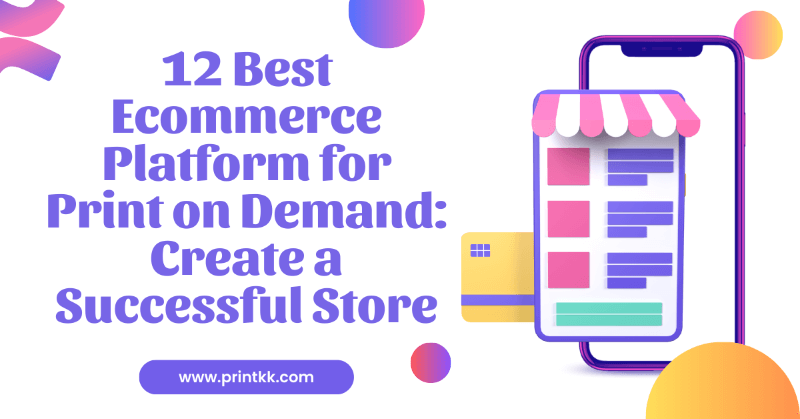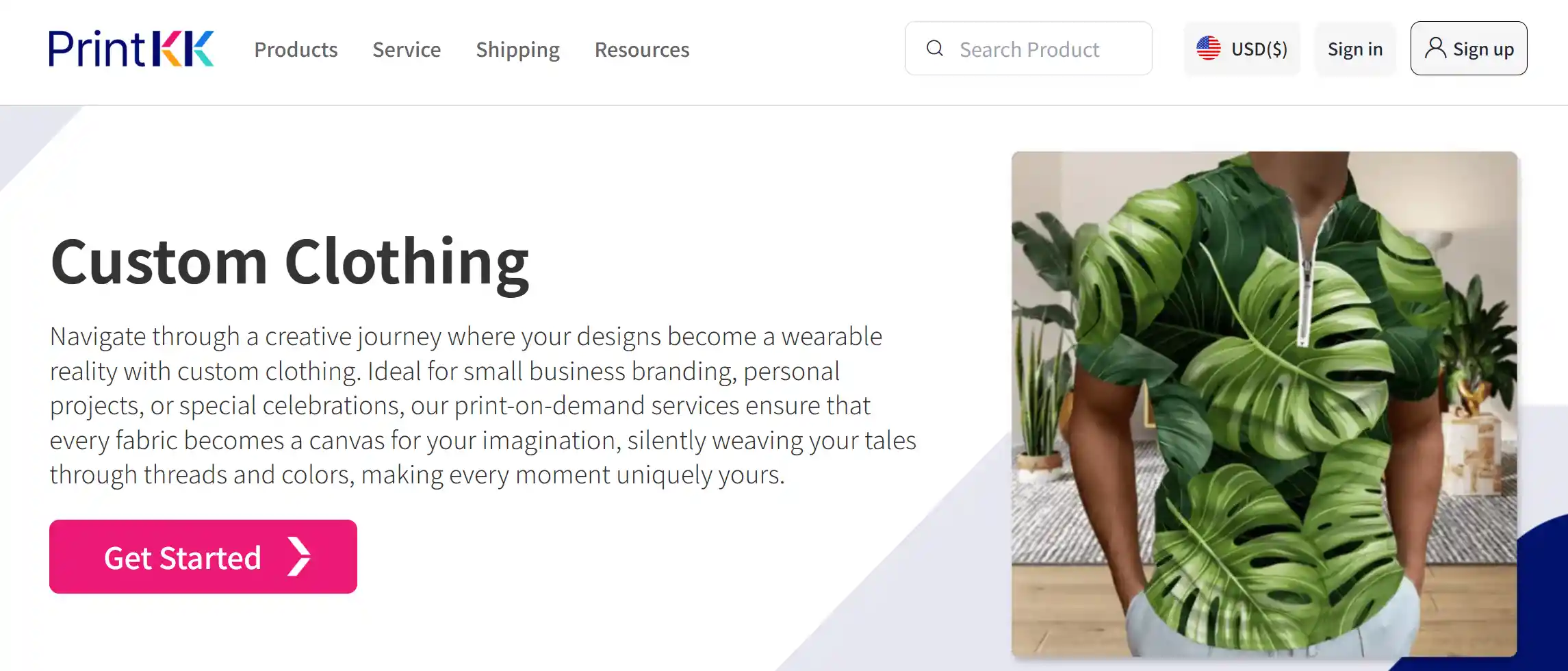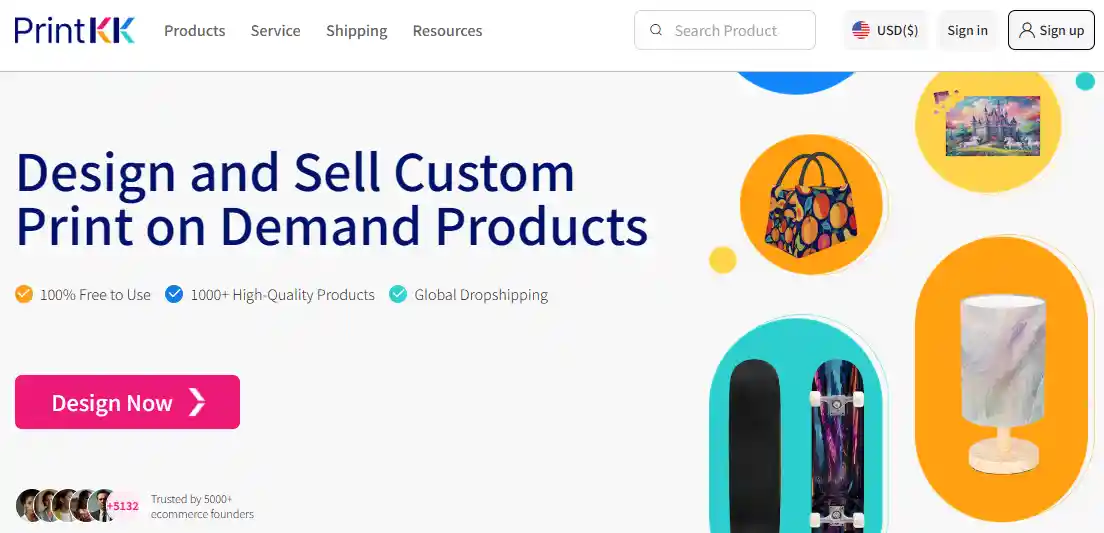
Let's explore an e-commerce platform tailored for print on demand success! The potential of online markets is huge, with global retail e-commerce sales expected to approach $8 trillion by 2028. Whether you are an individual artist or a large business, choosing the right e-commerce platform can unlock the potential for wealth.
A powerful e-commerce platform makes it easy to integrate print on demand businesses and help you open successful stores with ease. Follow me and start your e-commerce journey!
What Is Print on Demand?
Print on Demand (POD) does not require you to accumulate a large inventory, you can freely create the custom product you want. When a customer places an order, the product is manufactured and shipped directly from the supplier. This model can avoid the trouble of the inventory economy in the early stage and reduce the risk of unsalable products. From fashion clothing to lifestyle accessories, any product can be your unique design.
A print-on-demand service will help you handle the process of making and shipping your product, and you just need to update your product design based on customer response. Print on Demand service providers also provide excellent customer support to answer any questions you may have and help you make your sale.

The Necessity of Finding a Suitable Ecommerce Platform for Print on Demand
Integration with POD Services
Choosing the right e-commerce platform for your print-on-demand business is crucial for success. A suitable platform ensures seamless integration with POD services, allowing you to automate order processing and fulfillment.
This automation saves you time and reduces the risk of errors, letting you focus on growing your business. Platforms that specialize in e-commerce for printers can offer specialized tools designed specifically for print-on-demand businesses, helping you streamline operations.
Robust Tools
A good e-commerce platform provides robust tools for managing your online store. From inventory management to marketing features, these tools help you optimize your operations and reach a wider audience.
Whether you're seeking the best free e-commerce printing website or a fully featured platform, the right platform will also offer customizable templates and design options, enabling you to create a unique and professional-looking storefront that resonates with your brand.
Customer Experience
Customer experience is another vital factor. Customers often abandon transactions when shopping online, with 35% of online shoppers in 2025 abandoning transactions because of payment-related issues.
A reliable e-commerce platform will offer secure payment gateways, fast loading times, and mobile-friendly interfaces, ensuring a smooth shopping experience for your customers. If you're using a free online store app, make sure it offers these crucial features to maintain customer satisfaction and drive repeat business.
.jpg)
How to Find a Suitable Ecommerce Platform for Print on Demand?
Step 1: Identify Business Goals
You need to define a clear goal for your business. Please consider your specific needs, do you want to achieve rapid expansion of the store or do you want to provide a more suitable theme store for your brand? Writing down all the priorities you need helps narrow down your options.
Whether you are exploring e-commerce print-on-demand solutions or need something more customizable, it's important to prioritize functionality that aligns with your business vision.
Step 2: Consider Integration with POD
Once you understand your requirements, you can evaluate the target platform's integration with the POD. Seamless integration with an on-demand printing service like Printify or PrintKK is important for your business. Automating order processing and inventory updates can save you time and improve efficiency, streamlining operations. You can check out case studies and user reviews to see how these platforms are being used in practice.
Step 3: Assess Customer Support
It is also critical to evaluate the platform's user support capabilities. Good user support can give customers a more satisfying shopping experience and encourage them to buy again. Secure payment features protect your interests and those of your customers. At the same time, the 24-hour customer service platform can also help you solve any problems in the sales process in time to ensure the normal development of your business.
12 Best Ecommerce Platforms for Print on Demand
Shopify

Shopify is a leading e-commerce platform that offers seamless integration with on-demand printing services like Printify and PrintKK, making it a great choice for entrepreneurs and personal businesses.
Pros:
Shopify's website design is so intuitive that beginners can easily personalize and manage their store through a variety of apps and plugins. Shopify also offers all-day email, phone and chat services that can help you with a variety of issues. Shopify also supports payment methods like PayPal, Shopify Payments, and Stripe to give you a better sales experience.
Cons:
In the design process, the advanced theme needs to pay, and the free theme is less. Some advanced reporting or third-party shipping capabilities need to be available on a more expensive package. If you don't use Shopify Payments, transaction fees will be charged for every sale, which will increase your costs.
BigCommerce
BigCommerce has strong scalability and can meet the growth needs of large enterprises. It integrates perfectly with print on demand services, providing tools to manage large inventory and sales channels.
Pros:
BigCommerce can save you more money in the long run because it doesn't charge transaction fees. BigCommerce comes with advanced SEO tools to help you optimize your store's ranking and drive more traffic and sales. With the help of BigCommerce, you can sell on platforms like Facebook and eBay, and multiple channels operating together can help increase your brand awareness and drive more sales.
Cons:
For beginners or people who have not systematically learned the relevant technical knowledge, the interface of BigCommerce is not intuitive or even complex. Some features are only available on pricier plans. Features like abandoned cart saver and Google customer reviews are only available on higher-tier plans. At the same time, the platform has a sales limit, beyond which you need to upgrade to a more expensive plan.
Read more:
Squarespace
.png)
Squarespace has beautiful design templates that are perfect for designers who want to showcase their artwork. The platform is easy to use and integrated with POD, and is also very friendly to novices.
Pros:
Squarespace has an amazing array of templates, the best of which can help you better showcase your unique designs and customize your products. The platform also has a built-in blog function, so you can share the story behind the design. Easy-to-use drag-and-drop builders and built-in analytics to track website performance make it easier to build an online store.
Cons:
Some advanced e-commerce features are missing, and features such as advanced inventory management and multi-channel sales are limited. There are fewer payment methods to choose from than some of your competitors, and you'll be charged higher transaction fees if you don't use Squarespace's payment processing.
WooCommerce
WooCommerce is a flexible, open-source e-commerce solution built on WordPress. It integrates with a variety of Pods and offers a wide range of customization options to help you better design your own store.
Pros:
WooCommerce has a large networking community and extensive resources to help you learn and understand how to open a store. The basic WooCommerce plugins are all free to use, and there are thousands of plugins and themes waiting for you to use and extend the store. You can also seamlessly integrate with WordPress and use powerful CMS features to enhance your store.
Cons:
You need to be responsible for the security and maintenance of the website yourself, not suitable for beginners, need to have a certain technical knowledge of people to use. While the core plugins are free to use, more advanced themes or features cost extra.
Read more:
Ecwid
.png)
Ecwid is a flexible e-commerce solution that allows you to add a store to any website or social media platform. It integrates smoothly with POD services and is known for its ease of use.
Pros:
Ecwid can be added to existing websites and is easy to integrate with any website, including WordPress, Joomla, and more. Ecwid is a free program that is perfect for small stores and allows you to start selling online without any upfront costs. Ecwid updates automatically, so you always have the latest features. You can also use the Ecwid mobile app anytime, anywhere, so you can easily manage and monitor your store.
Cons:
Customization options are limited and the design is less flexible than some competitors. Advanced features require a lockout, while merchants with free plans charge transaction fees, resulting in a certain increase in costs.
Sellfy
Sellfy is perfect for small entrepreneurs selling both digital and physical products. This platform is simple to use and supports POD integration, making it a good choice for artists and designers.
Pros:
Both digital and physical products can be sold on this platform, and there is no extra cost for each sale, helping you keep more profit. The platform comes with marketing tools such as discount codes and upsell to help you get more sales.
Cons:
Sellfy has limited scalability and is not suitable for large businesses selling large quantities of items. And Sellfy has fewer customization options, making it difficult to meet the needs of a personalized custom store. The platform also lacks advanced reporting and analytics capabilities.
Wix
.png)
Wix is a versatile website builder. You can easily integrate with POD services and drag-and-drop editors, and then create your own site.
Pros:
The platform is easy to use and suitable for novices, with drag-and-drop and other features that require no coding skills to build and customize your own store and get it up and running in minutes. Wix has a wide range of design templates and marketing tools to help you design a unique store and sell your products.
Cons:
The platform is less scalable for large businesses and may not be suitable for stores with large inventory or high foot traffic. More advanced features require the purchase of advanced packages, and customization options are less flexible than on open source platforms.
Read more:
Magento
Magento is an e-commerce platform for large enterprises that is flexible and powerful and integrates well with POD services.
Pros:
Magento has a high degree of scalability and advanced features, able to handle the store's large inventory and high traffic. Extensive customization options give you complete control over the details of designing your store, and extensive community and online resources can help you run your store better.
Cons:
The platform is expensive to host and develop, and costs can increase with advanced hosting, themes, and extensions. You need constant maintenance and updates, which can be difficult for beginners without technical knowledge.
Big Cartel
Big Cartel is a website designed for artists and small manufacturers. This platform is easy to use and you can easily sell your products here.
Pros:
The platform is easy to operate, doesn't require much technical knowledge, and you can quickly set up and launch your store. The platform's affordable, low-cost program is ideal for artists and small manufacturers who fit a limited catalog, making it ideal for small stores. And the platform is mobile-friendly and responsive design ensures a great shopping experience on any device.
Cons:
Compared with other e-commerce platforms, the platform has fewer advanced and customized functions, and the design flexibility is poor, which is difficult to meet the needs of highly personalized stores. Moreover, the scalability of the platform is limited, and it is difficult to meet the large enterprises with a large number of products.
Square Online
.png)
Square Online offers a seamless way to create an online store integrated with Square's payment processing. It supports POD services and provides a user-friendly interface.
Pros:
The platform's simple and intuitive setup process allows beginners to quickly get up and running and open a store in minutes. All templates are suitable for mobile devices, and built-in email marketing and SEO tools can help you get more sales. At the same time, the built-in Square integration simplifies payment processing and gives you a better sales experience.
Cons:
The platform has limited customization options, and advanced features require you to purchase a more expensive plan to use. The platform charges a transaction fee for each sale, which can also increase your costs.
Hostinger Website Builder
Hostinger Website Builder is a platform that supports e-commerce capabilities and is easy to use. You do not need to have professional technical knowledge, only need simple operations to be able to open a store.
Pros:
The low cost of the platform allows small businesses to use it. A simple drag-and-drop builder lets you use it without coding. A wide selection of custom templates can help you create personalized stores with built-in tools that can improve your website's search engine rankings.
Cons:
Compared to the competition, there are limited application and plug-in options and fewer integration options. Scalability is limited for large enterprises and it is difficult to meet their wide range of product choices.
Shift4Shop
.png)
Shift4Shop, currently only available to entrepreneurs in the United States, is an e-commerce platform capable of integrating with POD.
Pros:
Shift4Shop doesn't charge extra for each sale and can keep more profit for you. A variety of order payment options can improve the shopping experience of customers. The platform also has 24-hour customer support to help you solve the problem of opening a store.
Cons:
The platform is currently only available to entrepreneurs in the United States. Advanced features require the purchase of more expensive plans, and there are fewer applications for extended features, which are difficult to meet more personalized needs.
How Do Ecommerce Platforms That Connect to POD Services Process Payments?
E-commerce platforms integrated with print-on-demand services streamline payment processing to ensure a seamless experience for both sellers and buyers. When a customer places an order, their payment details are securely transmitted to the platform's payment gateway. This gateway serves as a mediator, encrypting the information and sending it to the payment processor for verification. The payment processor then communicates with the customer's bank to confirm the availability of funds and the legitimacy of the transaction.
Upon successful authorization, the payment processor sends a confirmation back to the payment gateway, which notifies the e-commerce platform. Simultaneously, the print-on-demand service is alerted to begin fulfilling the order. This integrated system ensures that payments are processed quickly and securely, allowing you to focus on designing and marketing your products. The efficiency of this process not only enhances customer satisfaction but also helps maintain the smooth operation of your online store.
PrintKK--A Trustworthy Print on Demand Service Provider

PrintKK is the print-on-demand service provider you can rely on. PrintKK integrates seamlessly with various e-commerce platforms, allowing you to easily set up your own online store. You can quickly upload your own designs and sell them. Whether it's fashion clothing or home decor, PrintKK offers ample opportunities to help you show off your creativity.
PrintKK is also committed to improving customer satisfaction and ensuring that buyers have a quality shopping experience. They provide 24/7 customer support to help you with any questions you may have. The pricing of PrintKK is transparent, and this competitive price can help you build higher quality products and achieve higher profits.
Conclusion
Choosing the right print on-demand e-commerce platform can help you achieve business success. Whether it's a highly scalable platform or one that offers a wide range of art design templates, it can help your store stand out. Choosing the best platform depends on your unique needs. Consider all aspects of your budget and technical capabilities, evaluate the pros and cons of each platform, and find the best fit to maximize your profits. Get on your e-commerce road now!
FAQs
What is the cost of opening a store in ecommerce platform?
The cost is different for each platform. On Shopify, for example, you only need to pay $29 per month to start your store.
On which platform is it cheaper to sell print-on-demand products?
Programs on platforms like Big Cartel and Ecwid are more affordable and suitable for novices and small entrepreneurs.
What is a good profit margin for print-on-demand?
This margin is usually between 20-50%. The exact number depends on the cost of your product and your sales strategy.
Which e-commerce platform is the most used?
Shopify is one of the most popular e-commerce platforms, widely used by both businesses and individuals.










 Made in USA
Made in USA


 Global Shipping
Global Shipping



























